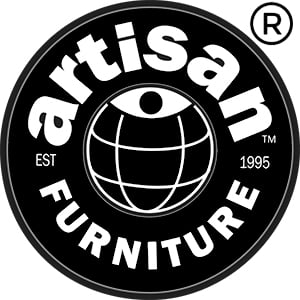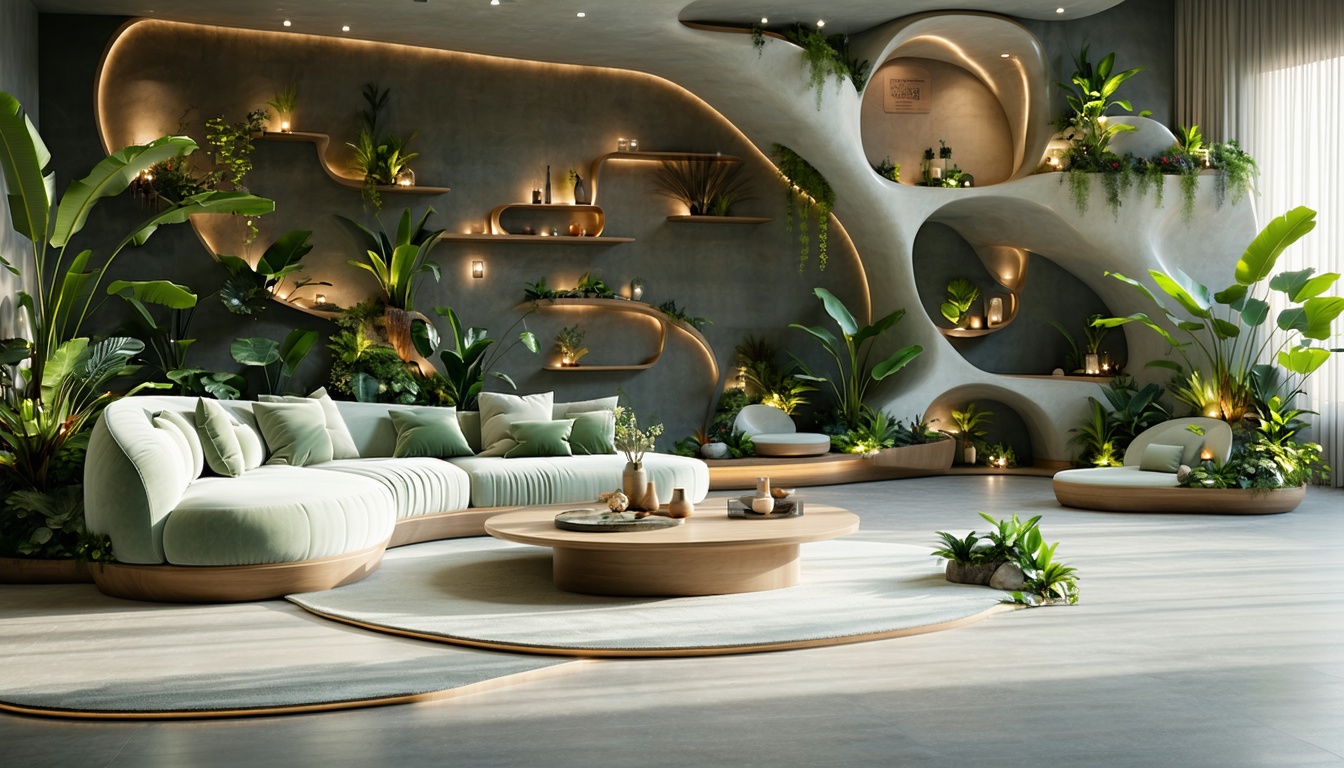Sustainable Materials for Curved Furniture
Choosing sustainable materials for curved furniture not only benefits the environment but also enhances the beauty and functionality of living spaces. Homeowners seeking unique furniture options can explore a variety of eco-friendly materials.
Bamboo in Furniture Design
Bamboo is an increasingly popular choice in furniture design due to its rapid growth and strength. It is a highly renewable resource, making it a sustainable option for crafting durable and stylish curved furniture. Saxen sources bamboo along with other high-quality natural materials, aligning their production with sustainability goals.
Some advantages of bamboo include:
| Feature | Details |
|---|---|
| Growth Rate | Up to 91 cm per day |
| Durability | Comparable to hardwood |
| Environmental Impact | Low carbon footprint |
Bamboo’s flexibility allows for innovative designs, creating soft-edged pieces that enhance the organic shapes in living spaces.
Recycled Polyester for Sustainability
Recycled polyester is another sustainable option for furniture, especially in upholstery. It emits 79% less carbon emissions than new polyester, providing an eco-friendly alternative. By utilizing waste materials, recycled polyester prevents valuable resources from ending up in waterways and landfills, making it a responsible choice for sustainable curved furniture options.
| Environmental Benefit | Impact |
|---|---|
| Carbon Emissions Reduction | 79% less than new polyester |
| Landfill Diversion | Reduces plastic waste |
| Waterway Protection | Less waste entering ecosystems |
This material can be used in a variety of seating options, including curved sofas and lounge chairs, that are both stylish and sustainable.
Advantages of Hemp in Furniture
Hemp presents multiple advantages as an environmentally friendly material for furniture. Compared to conventional crops like cotton, hemp requires significantly less water and fewer pesticides. This fast-growing plant utilizes all parts for various applications, making it a versatile choice for innovative furniture design.
| Benefit | Details |
|---|---|
| Water Usage | Requires 50% less water than cotton |
| Pesticide Necessity | Minimal pesticide use |
| Growth Speed | Harvestable in 3-4 months |
Hemp can be utilized in upholstery and other furniture components, contributing to the trend of sustainable curved furniture options with its natural textures and durability. For more ideas on curved furniture, explore our collection of curved furniture ideas.
Incorporating Organic Shapes
Organic shapes are increasingly popular in furniture design, particularly for their ability to enhance living spaces. Curved furniture offers both aesthetic appeal and functional benefits, seamlessly integrating with various layouts while contributing to a modern yet timeless feel.
Displaying Movement in Design
Curved surfaces can add a sense of movement to a space. These designs not only enhance aesthetics but also serve practical functions. For example, curved furniture can creatively zone areas, acting as both functional pieces and elements of the room’s architecture. Innovations like 3D construction printing and Building Information Modeling (BIM) have made it easier to visualize and create complex curved geometries, allowing designers to push the boundaries of traditional furniture design.
| Benefit of Curved Design | Description |
|---|---|
| Aesthetic Appeal | Curved shapes are naturally inviting and can soften the look of a space. |
| Creative Zoning | Curved furniture can define areas within open floor plans. |
| Functional Architecture | Certain curved designs can serve as load-bearing walls. |
Applying 3D Construction Printing
Advancements in technology, such as 3D construction printing, have revolutionized the process of creating uniquely curved furniture. This method allows for the fabrication of intricate forms that were previously difficult to achieve with conventional manufacturing techniques. Curved surfaces can be 3D printed using materials like concrete, ensuring that these innovative pieces maintain quality and performance standards while showcasing unique shapes. Innovations such as Mesh Mould and Curvecrete further enhance the capabilities of 3D printing in creating sustainable curved furniture options.
Steam Bending Techniques
Steam bending is a traditional technique used to achieve desired curvature in wooden furniture. This method allows wood to bend and take on organic shapes while taking advantage of its natural properties. Techniques like Glued Laminated Wood and Kerfing are also used to create smooth and flowing lines in furniture design. By utilizing these methods, designers can produce curved wooden pieces that are not only visually striking but also durable and practical for everyday use.
Through these innovative approaches, incorporating organic shapes into furniture design continues to change how homeowners view and utilize their living spaces. For more inspiration, explore our guides on nature-inspired furniture design, curved furniture ideas, and modern curved furniture designs.
Modern Applications of Curved Designs
Curved designs are making a significant impact in contemporary furniture and architecture. Homeowners and designers appreciate the aesthetic versatility and functional benefits that these organic shapes provide. Below are some of the modern applications of curved designs that highlight their innovative uses.
Creative Uses of Curved Glass
Curved glass is increasingly utilized in modern architecture, enhancing both aesthetic appeal and structural integrity. Advanced technologies such as bending and tempering, hot bending, cold bending, and laminated bending enhance the flexibility of glass, enabling the creation of custom-curved windows and glass elements. These innovations play a vital role in contemporary designs, allowing for fluid and visually striking architectural features.
| Glass Bending Technique | Description |
|---|---|
| Hot Bending | Glass is heated and molded into a desired curve |
| Cold Bending | Glass is bent into shape without heat, maintaining its strength |
| Laminated Bending | Layers of glass are bonded together to create curves while improving safety |
Incorporating curved glass elements can elevate a space, contributing to a seamless integration of light and form.
Superadobe Technique in Architecture
The Superadobe technique offers an innovative approach to building with curves, utilizing sandbags filled with moistened earth that are arranged in layers or long coils. This method is reinforced with barbed wire and plaster, providing high stability and strength for dome-shaped structures. Its inspiration from traditional earth architecture results in sustainable and aesthetically pleasing buildings.
| Superadobe Building Feature | Benefits |
|---|---|
| Stability | Offers high strength without needing additional structural elements |
| Sustainability | Utilizes natural materials, reducing environmental impact |
| Aesthetic Appeal | Creates organically-shaped and visually engaging structures |
This technique aligns with trends in sustainable curved furniture options, highlighting that form and function can coexist beautifully.
Curved Wall Siding Innovations
Curved wall siding is becoming a significant feature in modern architecture, providing an alternative to rigid, linear aesthetics. This innovation introduces fluidity to building designs and encourages a natural flow within spaces. Architects and designers appreciate curved wall siding for its ability to blend style with functionality.
| Curved Wall Siding Benefit | Result |
|---|---|
| Creates Visual Interest | Breaks away from traditional linear designs, making spaces more engaging |
| Enhances Flow | Promotes a sense of movement and comfort in architectural layouts |
| Versatility | Adapts to a variety of design styles and requirements |
By embracing these unique applications of curved designs, homeowners can achieve a contemporary and inviting atmosphere in their living spaces. For more inspiration, explore our collection of modern curved furniture designs and curved furniture ideas.
Sustainability in Furniture Production
The push for sustainable curved furniture options is reshaping the furniture industry. Emphasizing eco-friendly practices, designers are turning to innovative materials and production techniques to create unique and environmentally responsible pieces.
Utilizing Waste Textiles in Design
Utilizing waste textiles in furniture design is becoming increasingly popular. By recycling textile remnants, designers can contribute to sustainability while creating visually appealing furniture. The flexibility, durability, and sustainability of materials like Resysta siding promote this trend.
| Material Type | Benefits |
|---|---|
| Waste Textiles | Reduces landfill waste and promotes recycling |
| Resysta Siding | Flexible, durable, and supports innovative designs |
This approach not only helps reduce waste but also allows for the creation of furniture that aligns with the organic shapes favored by modern homeowners. Designers are effectively incorporating these materials into their work, enhancing the aesthetic appeal of living spaces.
Eco-Friendly Materials Analysis
A detailed analysis of eco-friendly materials, specifically waste textile-starch blends, demonstrates their viability for furniture production. Research has assessed the mechanical properties and performance characteristics of these sustainable materials, indicating they can meet functional requirements while minimizing environmental impact.
| Properties | Waste Textile-Starch Blends |
|---|---|
| Mechanical Strength | Comparable to conventional materials |
| Environmental Impact | Significantly reduced due to recycling efforts |
| Performance | Suitable for various furniture applications |
Incorporating these materials not only supports the movement towards sustainable design but also aligns with the growing trend of nature-inspired furniture. The resulting pieces are not only functional but also contribute to an eco-conscious lifestyle.
Implementing Microwave Puffing Technology
Innovative methods such as microwave puffing technology are being explored to enhance sustainable furniture design. This technology allows for the paste and gelation of starch, enabling the creation of furniture solutions that utilize waste textiles effectively.
The microwave process helps in optimizing the properties of the materials used, promoting an eco-friendly approach to production. This advancement ensures that furniture is not only stylish but also responsible.
| Technology | Benefits |
|---|---|
| Microwave Puffing | Enhances material properties and reduces waste |
| Paste and Gelation of Starch | Creates versatile designs from recycled textiles |
By harnessing these innovative techniques, the furniture industry is taking significant steps towards sustainability. Homeowners seeking unique curved furniture pieces can feel confident in their choices as they contribute to environmentally friendly practices. For more ideas on how to incorporate these aesthetic trends, check out our selection of curved furniture ideas and modern curved furniture designs.

